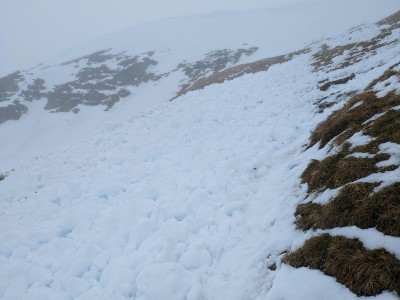
I had the day off work and decided to go for a solo walk up the four Glen Strathfarrar Munros. The weather had been very mild for February, and having been up a few Corbetts the week before I knew there wasn’t much snow on the hills. I still packed winter kit (ice axe and crampons) out of an abundance of caution, and felt fairly confident having taken a winter skills course the year before and made sure to practice those skills earlier in the season. I quickly checked the avalanche forecast, which was low in all areas and aspects. I also briefly thought about route planning and avalanche safety – I would be up on ridges almost all day, and felt comfortable with that. The walk in mostly confirmed this – there was only a few small snow patches up to 1000m, although I did spot bigger snow accumulations on the far side of a corrie.
The walk along the ridge was fairly uneventful, covering wet mossy ground with only a couple of snow patches – mostly avoidable, all soft and none very deep. By the time I got to the final Munro (Sgùrr Fhuar-thuill), I was feeling pretty tired, but was on track with about two hours of daylight left to get down. Descending to the bealach with Sgùrr na Fearstaig, I noticed the corrie below had bigger and deeper snow patches than the ridge. On the way down, I was initially just annoyed as postholing through the wet snow made progress fairly slow. I noticed some small snowballs rolling down the steep rocky slope and thought this would be a bad time to slip.
A few minutes along the path down the corrie, I heard a continuous wet sloshing sound. I initially thought it was a stream, but knew there wasn’t any marked on the map nearby. Listening more closely I realised I was hearing an avalanche – the sound continued for about 20 seconds and then stopped. At this point I was tired, had soaking wet feet from walking through snow, and was caught up in the hope of getting down to the road as directly and quickly as possible. I knew the ground I was traversing was steep, with significant snow accumulations in patches, but the alternative of retracing my steps to pick an alternative route over pathless ground was unappealing. I continued the route I had originally planned, passing the remains of two avalanches along the way, as well as some snow fields which I very carefully picked my way through. I made it down to shallower ground and got back to the road with plenty of daylight.
In hindsight I was lucky to have gotten away with it. If the avalanche I heard had not gone off naturally just before I passed through, I would have likely triggered it. Any of the other undisturbed snow fields I passed could also have avalanched, best case scenario taking me off my feet, worst case resulting in serious injury. I had continued into a dangerous situation due to my own tired state, the lack of a partner to discuss with, and the existence of a pre-made plan and lack of alternatives – all textbook human factors in poor avalanche decision making. I was also lulled into a false sense of security by superficial planning – although most of the day was on ridges, the corrie walls had slopes of 25°-40° (the avalanche goldilocks zone). The avalanche forecast for a nearby region, although low overall, mentioned wet snow as a risk factor. While avalanche safety had been discussed during my winter skills training, the conditions were very different – I had much better awareness of risks such as windslab and cornices than wet snow. Knowing nothing can be dangerous but knowing a little bit even more so!
Overall it was a humbling experience for me, and a good day to learn from. I just felt lucky I was able to chalk it up to experience without any more serious consequences!
The Scottish Avalanche Information Service publishes a daily forecast of avalanche, snow and climbing conditions for six areas of Scotland each winter. You easily access to these reports, receive important alerts and measure slope angles on your phone by downloading the “Be Avalanche Aware” App.